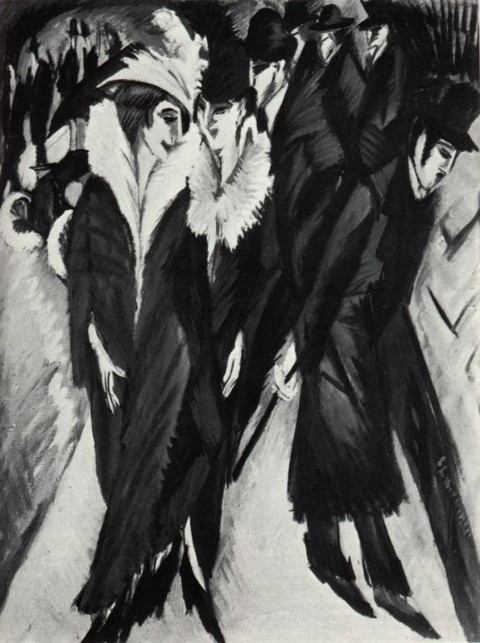

"Man and His World International Fine Arts Exhibition Expo 67 Montréal Canada" by Pierre Dupuy © the Canadian Corporation for the 1967 World Exhibition and the National Gallery of Canada
| Ernst Ludwig Kirchner. 1880-1938
The Street. 1913 In 1905, four young men, Heckel, Schmidt-Rottluff, Kirchner and Bleyl, had started the movement known as Die Bruecke (The Bridge), the German counterpart of Fauvism in France. It was their aim to "assemble all the revolutionary and fermenting elements of the time." First they developed a collective style, the most significant characteristics of which were aggressive colour and the distortion of forums. Later, after they had separated over the interpretation of their roles and aims on the occasion of a "chronicle" written by Kirchner in 1913, each of the artists developed his own personality. Kirchner, the oldest, was the most versatile, intellectual, and sensual of the group. HIs picture The Street, painted in the year the group separated, was acquired by the National Gallery in Berlin; there it remained until 1937 when it was forcibly removed by the Nazis as "degenerate art," and publicly held up to scorn in exhibitions ridiculing such art. It was finally brought to the United States. In the picture, prostitutes and men create a vicious atmosphere. The flat colour is splintered, gloomy and voluptuous, and slit into long narrow strips. The girls with their furry and feathery hats, and the men flaunting themselves and stalking behind look like strange birds, black, blue and purple, set against a sensuous background of red. Unlike the other members of Die Bruecke, Kirchner loved to choose more or less degraded people as subjects. He depicted the neurotic atmosphere of the demi-monde of artists, studios and models, bathers and dancers. In all his pictures, even his landscapes and his black and white woodcuts, he expressed a nervous excitement and vibrancy. In 1917 he moved to Switzerland for his health. But it was only in the late twenties and thirties that he changed his technique and painted in large, flat shapes, almost like tapestries, with bold, light colours. Stricken with illness, and overwhelmingly depressed after the Nazis seized 639 of his works from public collections, he committed suicide in 1938. |